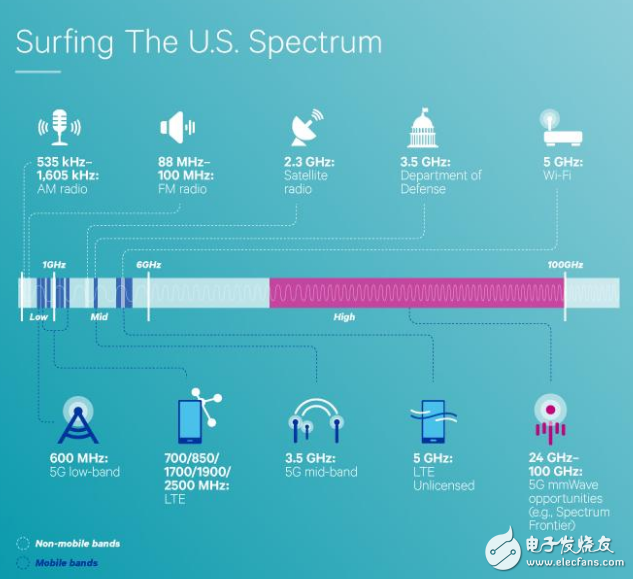On November 11, 2016, Qualcomm published an article on its official blog about the wireless band in the US for the future 5G era.
Let's take a look at the main content.
In the 5G era, in order to be able to use a wider frequency band than the previous mobile broadband, it is necessary to develop new frequency bands available in the future. The frequency bands available for advancing 5G are as follows.
Low frequency band below 1 GHz: Due to its long wavelength and long propagation, it can be used for mobile broadband requiring wide area coverage and a large number of low power IoT sensors for underground and indoor use.
Medium frequency band from 1G to 6GHz: It can ensure large bandwidth and can send a large amount of data. It is also suitable for mission-critical delivery in smart cities, factories, and medical equipment.
High frequency band above 24 GHz (millimeter wave): It can ensure large bandwidth and can transmit data at speeds up to several Gbps. Although the distance of arrival is short, it is highly linear and suitable for connection to specific equipment, so it is suitable for mobile broadband in places with high population density.
On the other hand, the use of frequency bands classified by subordinates is also discussed.
Authorized band: Allows the mobile communication network operator to use it to provide an authorized frequency band.
Shared band: This is a band that is guaranteed for other purposes, but can be used when not in use or when it is open.
License-exempt band: A band that can be used without a license. In a limited area, it can be used together with various technologies such as wireless LAN, LTE related technology, and Bluetooth.
With regard to ensuring the success of 5G success and the continued evolution of 4G, the global regulatory authorities and the mobile communications industry that manage the frequency bands need to coordinate. In the United States, the Federal Communica TIons Commission (FCC) is advancing the following new initiatives.
Low frequency band: Advance auction in the 600MHz band.
Mid-range: Open the 150MHz band around 3.5GHz in the name of the CiTizens Broadband Radio Service (CBRS) in the United States.
High frequency band: Open 11 GHz bandwidth in the frequency band above 24 GHz (millimeter wave).

In addition, with regard to the use of these new frequency bands, in addition to testing the 2.3 GHz band with licensed Shared Access (LSA) technology shared with existing users, Europe has also taken many actions in technology development, such as the establishment of the “MulteFire Allianceâ€. ", to promote the MulteFire technology that implements the LTE system only in the license-free band, and the "CBRS Alliance" for the purpose of promoting the use of CBRS. (Reporter: Kato Shuko)
Heat-not-burn products, often known as heated products, simply heat the tea and herbal leaves, among other ingredients. A delicious vapor is produced during the heating process. When compared to cigarette smoke, the amounts of hazardous compounds are considerably lower since the substance does not burn.
Features:
1. Strong throat hit, each puff is the ultimate taste feast.
2. TPD, MSDS, and ROHS are available,make your rest assured.
3. Work with heat but not burn device, like IQOS, LIL, JOUZ...
4. Non tobacco ingredient but provide a real smoking feelings.
5. Extracted from pure natural tea, blended herbal essence.
6. No tar, no formaldehyde, and no second-hand smoke damage.
Flavor E Cigarette Stick,Regular E Cigarette Stick,Lemon Flavor E Cigarette Stick,Heat Not Burn E Cigarette Stick
Mainstay (Guangdong) biotechnology Co., Ltd. , https://www.heyleme.com